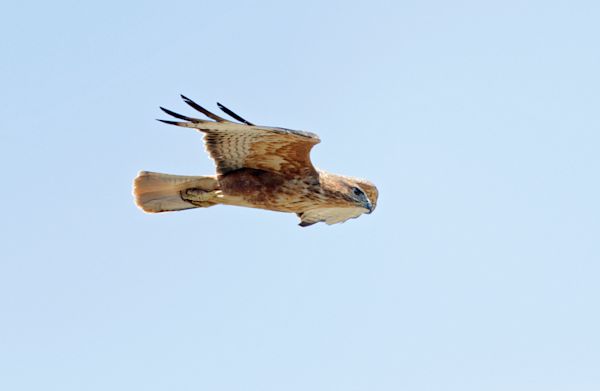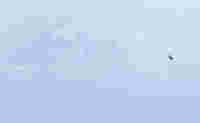I’m just back from a week’s tourleading and raptor watching around Tarifa, Spain, the southernmost town in Europe, just on the Strait of Gibraltar. And once again, I was reminded of the buzzard conundrum related to this area.
Already in the 1990’s, when I started to visit this region regularly, I remember seeing reddish Common Buzzards, quite similar to the Steppe Buzzards of my native Finland and the Steppe Buzzards I see on migration in the Middle East. However, according to the literature and also according to my Spanish friends the Steppe Buzzard had never been officially recorded in Spain, it was not on the Spanish list. These were in the days of film cameras and it was difficult to get close enough to document these shy birds properly, and although I managed to shoot some, including some vagrant African Long-legged Buzzards, I could never get close enough to the more interesting individuals.

An adult Gibraltar Buzzard
seen on my last trip from the Mirador del Estrecho near Tarifa on Sep 10th 2017. Note the strong rufous colours of this bird and particularly the red tail with in this case a broad black subterminal band. Such a tail is not found in either Long-legged or a Common Buzzard.
Then over a decade passed and knowledgeable birders moved to stay in this area. The buzzards were “re-found”, and not just the birds, even some nests were located. It was especially thanks to the work of Javier Elorriaga and Antonio-Roman Muñoz that this buzzard enigma was eventually solved. Their field work included trips across the Strait to northern Morocco and to the Spanish colony of Ceuta, on the southern shore of the Strait, where similar looking birds were known to breed.

The same adult from Tarifa
Sep 10th 2017, showing the dark, rather Common Buzzard-like upperparts except for the diagnostic red tail with a broad black tail-band.
In September 2012 the three of us together with two American birders made a trip across the Strait to look for these birds. In Ceuta we watched a breeding pair with fledged chicks and in Morocco proper we encountered several more. We had lengthy discussions on these birds, as Antonio and Javier were preparing a paper on their findings. The final conclusion was, that these birds were part of a hybrid population, hybrids and backcrosses between the African Long-legged Buzzard (aka Atlas Long-legged Buzzard) and Common Buzzards. Vagrant and migrant Common Buzzards from Europe had paired up with Long-legs on the Moroccan side, while in Spain vagrant Long-legs formed pairs with Common Buzzards (for details see Elorriaga, J. & Muñoz, A-R 2013: Hybridisation between the Common Buzzard Buteo buteo buteo and the North African race of Long-legged Buzzard Buteo rufinus cirtensis in the Strait of Gibraltar:prelude or preclude to colonization? Ostrich 84: 41-45).

Adult female Gibraltar Buzzard
one of the breeding birds of Ceuta The yellowish and rusty coloration stem from the Long-legged Buzzard as does the dark flank-patch, while the head and the lesser underwing coverts are darker than one would expect to find in a “pure” Long-legged.
Typical of a hybrid population (a hybrid swarm) like this, is that the birds are highly variable. Some look like Common Buzzards, with some features of Long-legged, while others can be almost identical to Long-leggeds save for some features clearly indicating Common Buzzard ancestry, and the rest can be anything between these two extremes. All in all, many of the birds resemble greatly the Steppe Buzzard, the eastern subspecies of Common Buzzard.

The upperparts
of the same breeding adult female from Ceuta. Note the finely barred but otherwise Long-legged Buzzard-like orange tail, while the head and the general upperts coloration is darker than in similar-looking Long-legged Buzzards.
Hybrids between different species of raptors were thought to be extremely rare in the past, but recent studies have revealed that they are in fact quite common. Hybridisation occurs also between other species of buzzards and it has been documented to take place also in harriers, falcons and spotted eagles, just to name a few. From an evolutionary aspect hybridisations like these could, at least in theory, be the start of a new species. If hybrids would interbreed only among themselves, with no genes from the original parental species being added to the population, they would with time form their own genetic entity. They would differ genetically from either of the parental species, which through hybridization would have given birth to a new, a third species. The isolation, which is required for this to happen, rarely occurs in nature, but isolated islands could serve as such a refuge, where vagrant birds from different closely related species could hybridize and with time form a new species. Speciation through hybridization could definitely be the fast track in evolution.

A juvenile Gibraltar Buzzard
in September in Tarifa. Told from similar looking juvenile Common Buzzard, by rufous head and uppertail coverts, very pale iris colour, light-edged upperwing coverts and almost uniform tail-feathers.
Dick Forsman is a Finnish ornithologist, author, artist and travel guide. Dick's deep interest in birds, raptors in particular, started during his early childhood and ever since he has built his life around this passion. http://www.dickforsman.com.
Photos and text © Dick Forsman













